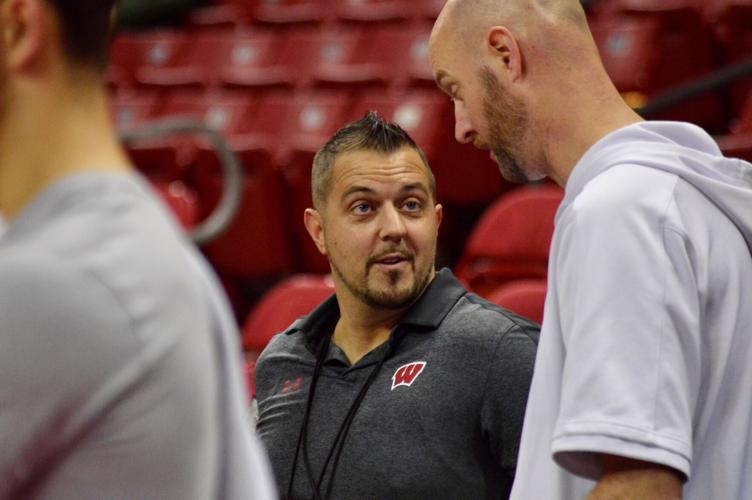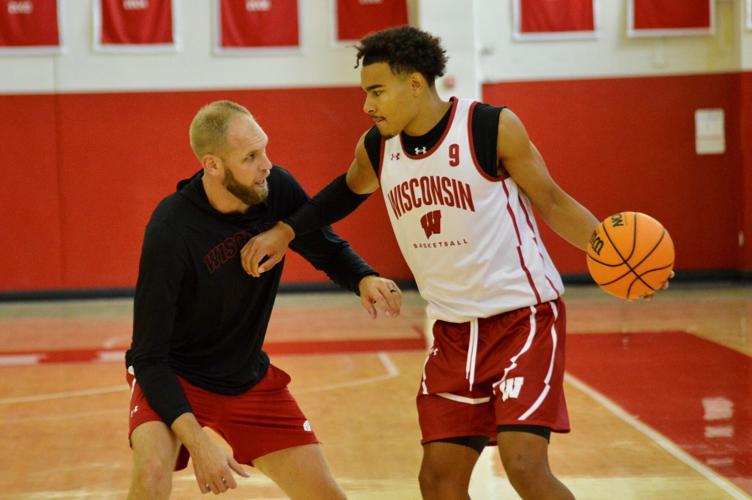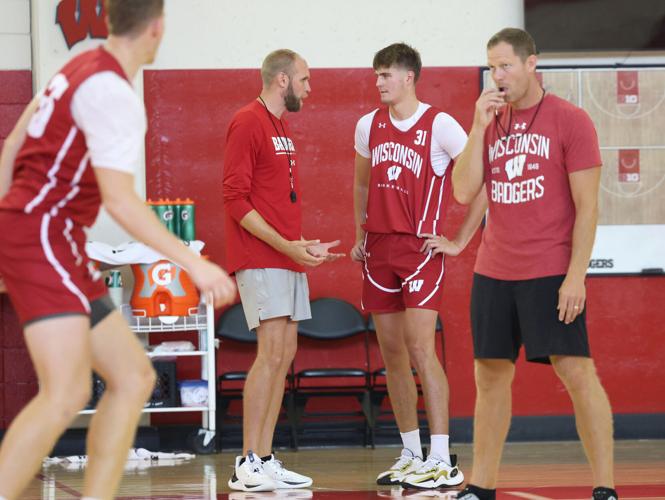The University of Wisconsin men’s basketball’s latest player development expansion has been in the works for several years, but the timing perhaps could not have been better.
As part of a $42.8 million addition to the Kohl Center, strength and conditioning coach Jim Snider was tasked this summer with overseeing the development of a new sports performance space between the main floor and courts at Nicholas-Johnson Pavilion. It was a unique opportunity, Snider acknowledged, and a grueling one.
But since joining the staff full time before the 2021-22 season, Snider had earned coach Greg Gard’s trust. And for members of his staff that do a good job, Gard told BadgerExtra in August, their responsibilities can grow. So, Gard said the Badgers’ weight room became Snider’s “baby.”
People are also reading…
“You don't get an opportunity to build a weight room like this very often,” Snider said.
May is normally a lean month, Snider said. But Snider was forced to stick around then, ensuring they received the proper equipment and that it was being installed to his liking.
In building the renovated space, while more aesthetically pleasing, spacious and packing in more natural light than the old weight room, Snider made every effort to ensure it was state of the art. There’s equipment from Sweden and Barcelona, Spain. There’s also technology with origins in other sports like World Cup soccer that Snider has researched and applied ways to bring to the Badgers’ basketball athletes.
“A muscle’s a muscle,” he said.

Strength and conditioning coach Jim Snider, center, talks with athletic trainer Brent Neuharth during a Wisconsin men's basketball practice Tuesday.
The project raced to a finish before June 17, the first day of summer workouts for the Badgers, and players were welcomed to the facility ready to make use of what was once just Snider’s vision. Because standing in the renovated weight room late June, Gard alluded that one factor stands above all for developing players in the most transient era of college basketball to date: time.
The Badgers know their time to work with players might be limited. Last season’s leading scorer, AJ Storr, was with the program for just one season. The Badgers have lost two of four scholarship freshmen from the 2022 and 2023 recruiting classes to the transfer portal. Point guard Chucky Hepburn developed in Wisconsin’s program for three years, but transferred away while seemingly right on the cusp of reaching his peak. The Badgers added three transfers in Camren Hunter, John Tonje and Xavier Amos. Players will come, players will go, and the timeline has never been so difficult to predict.
So, this offseason, Wisconsin seemingly emphasized what they could control. They made efforts to maximize their one-year development output, adding technology to inform how hard they could push players and adding a director of player development in program alum Greg Stiemsma to ensure development doesn’t fall into the background during the season.
There’s still a long-term vision, Stiemsma said. And Gard mentioned it’s also just “another tool in the toolbox” to pitch to international and transfer portal athletes, who have shrunk recruiting processes to just a few weeks compared to the several years spent with domestic high school recruits. In essence, Gard explained: This is what the Badgers will do to develop you as fast as possible.
“When you start talking about what you have as a program and how you can immediately impact development,” Gard said, “having a guy like Greg Stiemsma is a piece of that, having a brand new weight room that’s state of the art is a piece of that.”
But Wisconsin is also rethinking certain aspects of how they approach in-season development, which Gard said he thought was a needed improvement for his program’s future. The staff aims to challenge much of the notion that development opportunities dip when the season begins. Because for the Badgers to reach their potential, they have to.
“We make sure we can keep pushing limits,” Snider said, “without going over the limit.”
Wisconsin men’s basketball investing in development

Wisconsin director of player development Greg Stiemsma, left, instructs guard John Tonje shoots during Tuesday's practice inside Nicholas-Johnson Pavilion.
Stiemsma was intrigued by the idea of returning to his home state and alma mater after two years as a player development coach with the San Antonio Spurs. But a lot of what he would be doing in his newly created position at Wisconsin was left undefined. They’re still working things out, he said. But what was clear was Gard was interested in his experience in the NBA, which exists on the cutting edge of player development the Badgers hope to reach.
As summer workouts began, Stiemsma’s first task was applying something he took directly from his time with the Spurs: a player development program he refers to as “daily vitamins.” The workouts consist of around 20 minutes of skill work.
Skill work in and out of practice is nothing new, sophomore John Blackwell said, but what is new is there’s really no exception this year. Vitamin sessions are curated so that point guards, shooting guards, small forwards, power forwards and centers all work on exactly the skills that apply to them. Therefore, they’ve been able to eliminate the “mindless,” “fake hustle” portions of past practices. They can be more efficient with the time they have, even if it only earns them an extra 10 minutes of 5-on-5 work.
“That's kind of been my theme with these guys: When I get them on the court, when we're going through stuff, it's to have a purpose,” Stiemsma said. “It's with intention.”
For Carter Gilmore, he said that’s been enough to make this the best summer he’s experienced in his five years going through preseasons with the Badgers. Stiemsma said that the fullest potential of what his job could be might not truly begin until the season begins.
That, in essence, was Gard’s true vision with Stiemsma’s hire. Coaches' attention will eventually turn to scouting opponents. So if Steven Crowl’s free throw shooting needs work or Blackwell needs help scoring inside, that is something Stiemsma can identify. They’ll then adjust vitamin sessions to reflect the types of shots and situations players are getting in games.
Stiemsma’s development experience parlayed career averages of 2.7 points and 10.0 minutes per game with the Badgers into a four-season NBA career. So he understands what it takes to grow as a player. But in the case his explanation fails, Wisconsin will have the ability to present players with the data.
Snider said he now has access to more data than he ever has in his career. He said that’s not the only thing that’s important, and communicating with players is still a valuable way to assess how they’re feeling. But this summer, Wisconsin applied a software called Kinexon that could help inform what players are telling them. The Munich-based sports tracking and analytics software company is something Stiemsma has familiarity with using in the NBA and, at Wisconsin, has been used by Snider to track cardiovascular and joint load — among other things — for individual players throughout practice.
At a recent practice, Snider stood off to the side perusing the data on an iPad, which offers results in real time via straps worn by players or built into the spandex of some shirts. They have Oura Rings to track players' sleep. Technology can tell Wisconsin how hard they could train players. The data could show a few light days in a row, prompting a ramp-up. The data could show some heavy load recently, which would lead them to pull back.
“Some of these younger guys,” Stiemsma said, “I don't know if they know what their bodies are capable of.”

Wisconsin basketball director of player development Greg Stiemsma, left center, talks with Nolan Winter during Thursday's practice, the first open to reporters.
What Wisconsin could add to revamped player development
Tweaks and adjustments will become even more common as the season arrives, and players will enter different development programs depending on how many minutes they’re required to play. Snider even suggested that the Badgers could eventually look back at practice and training workloads surrounding good performances and bad performances, trying to formulate an ideal regimen.
Stiemsma said the Badgers could still add even more technology, such as something that could further track their shooting in practice.He doesn’t think implementing any new tech would come as a shock to players — a continued financial investment would just emphasize the importance of what Wisconsin is doing.
With all this advancement, Wisconsin still isn’t abandoning the old way. Badgers assistant coach Sharif Chambliss has encountered the scenario plenty of times: He’ll walk into the locker room and everyone's on their phone. But he wants players to talk to their teammates and coaches. Chambliss is relational by nature, and for him to know what is best for the players he’s coaching, it’s not about technology, it’s communication.
Wisconsin hopes that the changes won’t just benefit players acclimating to their first college programs, but perhaps even aid a jump of a five-year veteran like Crowl or one of their best players in Blackwell. But Stiemsma said there is a balance.
Crowl’s interior counterpart, freshman forward Riccardo Greppi, didn’t arrive in Madison until late August. Though Wisconsin wants to move fast, Snider acknowledged they could only develop so fast. Players will need about eight, 10 or 12 weeks of consistent training to make changes. Greppi hasn’t had that, yet.
But while it’s important to prepare players to play a role, there’s also an increased emphasis on what can impact the success of the Badgers this season. Crowl, with one season left, reaching the peak of his arc as a player at Wisconsin might be that.
“I'm not certainly going to take credit for it, but I'm going to be happy for them and root them on along the way,” Stiemsma said. “And I think if an outsider thinks that is a little bit of my doing, I think that'd be kind of fair, too.”
Photos: Go inside Wisconsin men's basketball's final open preseason practice

Sophomore guard John Blackwell participates in a drill during a Wisconsin men's basketball practice Tuesday.

Forward Steven Crowl prepares to shoot the ball during a Wisconsin men's basketball practice Tuesday.

Sophomore forward Nolan Winter participates in a drill during a Wisconsin men's basketball practice.

Strength and conditioning coach Jim Snider, center, talks with athletic trainer Brent Neuharth during a Wisconsin men's basketball practice Tuesday.

Wisconsin men's basketball coach Greg Gard watches a drill during practice Tuesday.

Assistant Joe Krabbenhoft watches a drill during a Wisconsin men's basketball practice Tuesday.

Assistant Lance Randall watches a drill during a Wisconsin men's basketball practice Tuesday.

Assistant Sharif Chambliss smiles during a Wisconsin men's basketball practice Tuesday.

Transfer guard Camren Hunter participates in a drill during a Wisconsin men's basketball practice Tuesday.

















































